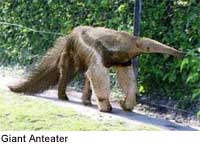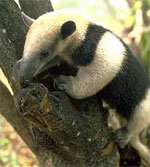|

 Giant Anteater: The largest representative of the group is the Giant Anteater, or Ant-bear (Myrmecophaga tridactyla), measuring 4 feet (1.2 m) in length without the tail, and 2 feet (60 cm) in height at the shoulder. It has a long, thin head and a large, bushy tail. It is mostly grey, with a broad black band, bordered with white, starting on the chest, and passing obliquely over the shoulder, diminishing gradually in breadth as it approaches the loins, where it ends in a point. Giant Anteater: The largest representative of the group is the Giant Anteater, or Ant-bear (Myrmecophaga tridactyla), measuring 4 feet (1.2 m) in length without the tail, and 2 feet (60 cm) in height at the shoulder. It has a long, thin head and a large, bushy tail. It is mostly grey, with a broad black band, bordered with white, starting on the chest, and passing obliquely over the shoulder, diminishing gradually in breadth as it approaches the loins, where it ends in a point.
 The two tamandua anteaters, as typified by the Southern Tamandua (Tamandua tetradactyla), are much smaller than the Giant Anteater, and are mainly arboreal. They inhabit the dense primeval forests of South and Central America. Their fur is usually yellowish-white, with a broad black lateral band, covering nearly the whole of the side of the body. The two tamandua anteaters, as typified by the Southern Tamandua (Tamandua tetradactyla), are much smaller than the Giant Anteater, and are mainly arboreal. They inhabit the dense primeval forests of South and Central America. Their fur is usually yellowish-white, with a broad black lateral band, covering nearly the whole of the side of the body.
The Silky Anteater (Cyclopes didactylus) is a native of the hottest parts of South and Central America, and about the size of a rat, of a general yellowish color, and is exclusively arboreal.

Range and habitat: The anteater populates many tropical parts of South and Central America, dwelling on low, swampy savannas, river banks, and the depths of the humid forests. While anteaters are spread out over South and Central America, they are few in number.
Diet: Its diet consists mainly of termites, which it obtains by opening their nests with its powerful sharp front claws. As the insects swarm to the damaged part of their dwelling, it draws them into its mouth by means of its long, flexible, rapidly moving tongue covered with sticky saliva. A full-grown giant anteater eats upwards of 30,000 ants and termites a day.
--------------------------------------------------------------------------------------------------------------------------
The Giant Anteater
No teeth! The Giant Anteater is one of only two mammals without any teeth even in a mature state (the Pangolin being the other). An ant eater instead crushes insects it consumes using hard growths found on the inside of its mouth, and its muscular stomach. Sand and small rocks have also been found in anteaters' stomachs, suggesting that these are ingested to aid digestion (possible gastroliths).
Giant sized: It grows to a size of 6 feet (1800mm) to 8 feet (2400mm) long, including a 3 foot (900mm) to 4 foot (1200mm) torso and tail. Generally it weighs from 65 (29 kg) to 140 pounds (65 kg).
Stiff-haired: The Giant Anteater is covered with stiff, straw-like hair which grows up to 40 cm long on the tail. Young have soft hair until it matures. The dominant colouring may be grey or brown, but all have a diagonal black and white shoulder stripe.
Senses: The Giant Anteater is generally acknowledged to have a keen sense of smell, used to locate ants, but is thought to have poorer sight and hearing.
Mis-named: Despite its name, Myrmecophaga Tridactyla, from the Greek meaning 'three fingers', the anteater has five digits on each foot; however the middle three digits of the forefeet have elongated claws. These are extremely strong and are used to break open ant and termite mounds in order to feed, as well as effective defence from predators. The anteater walks on its knuckles in order to protect them, giving it a shuffling gait. The forefeet also have one other smaller claw, and the rear feet have five small claws.
Long-tongued: The anteater has the longest tongue in relation to its body size of any mammal; its tongue can reach two feet (600mm) in length, with a width of only 1/2 inch (12.5mm). The anteater can cover its tongue in a sticky saliva, allowing it to trap ants, and can extend and withdraw it up to 150 times per minute.
A nomad: The Giant Anteater is a nomadic animal, moving from one anthill to the next. An anteater will switch to another nest when the stings become too frequent and painful.
No nest: The Giant Anteater does not sleep in any fixed place, instead curling up in abandoned burrows and hollows. It covers its body with its long, bushy tail to sleep.
One at a time: It bears a single offspring after a gestation period of 190 days, which will stay near the mother until she becomes pregnant again. The offspring spends much of the first part of its life riding on its mother's back, until it is nearly half her size.
Nocturnal near human settlements: In the wild, the Giant Anteater behaves nocturnally near human settlements and diurnally elsewhere. It stays mainly on dry ground but is a strong and capable swimmer.
Threat response: When threatened, it stands up on its hind legs, using its tail to aid balance, and may strike extremely rapidly with its claws or "hug" attackers much like a bear. An adult anteater is capable of fending off or killing even its main predators, big cats such as jaguar and puma.
Similar animals:
Pangolins are also called scaly anteaters.
The Numbat (Myrmecobius fasciatus), a marsupial, formerly called the Banded Anteater. This species is very endangered.
Echidnas, a family of monotremes, are still sometimes called spiny anteaters.
Aardvarks are African animals with similar habits.

The Giant Anteater produces one offspring per birth.
All text is available under the terms
of the GNU Free Documentation License
|